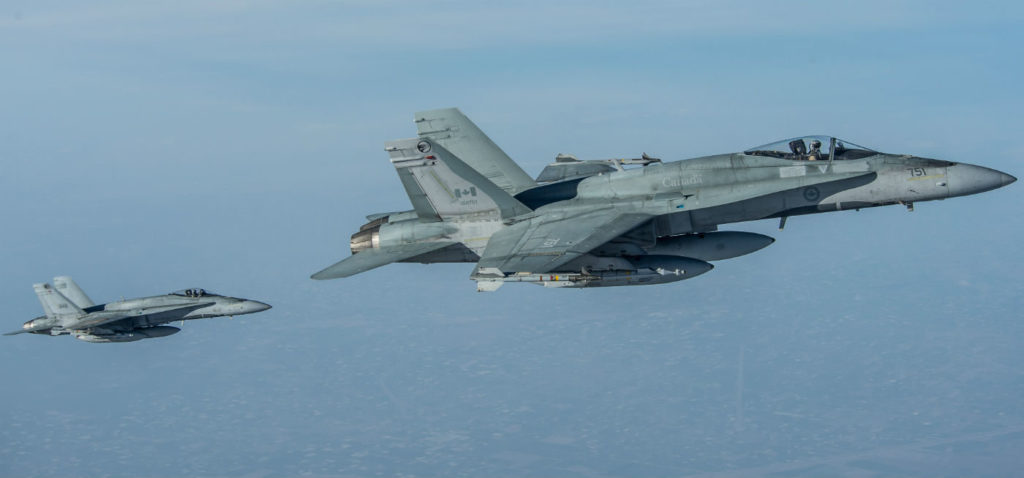Estimated reading time 7 minutes, 15 seconds.
Replacing Canada’s fleet of 76 CF-188 Hornets with 65 new fighter jets will not be enough to simultaneously meet Canada’s NATO and NORAD commitments, Defence Minister Harjit Sajjan acknowledged.

The former Conservative government had planned to acquire 65 Lockheed Martin F-35A Joint Striker Fighter aircraft as the eventual replacement for the Royal Canadian Air Force (RCAF) fleet of 30-year-old legacy Hornets before the project was paused in 2012 to evaluate the cost and procurement process.
Sajjan said neither the quantity nor the proposed acquisition budget of $9 billion are sufficient to meet alliance commitments or the various missions with which the RCAF is tasked.
“If we want to fully meet our commitments to NATO and NORAD simultaneously–and we do–then 65 jets would not be a full fleet,” he said. “It would only be a fleet for risk managing our requirements, not meeting them.”
The admission was part of a frank address to the Conference of Defence Associations Institute on May 3, intended to warn Canadians about the current state of military spending and the growing list of unfunded equipment and technical capabilities that the Canadian Armed Forces desperately require just to meet the basic operational demands of domestic and international missions today.
“We are now in the troubling position where status quo spending on defence will not even maintain a status quo of capabilities,” said Sajjan. “Current funding has us digging ourselves into a hole, a hole that gets deeper every year. As a percentage of our GDP, we are spending less on defence today than we were in 2005.”
“These aren’t ‘nice to haves’, these aren’t frills,” he added about a list of at least 18 projects that includes logistics vehicles and basic heavy support equipment for constructing airfields, camps and roads, and handling shipping and other containers. “These are projects that must be completed to allow our military to just keep doing what it’s doing…and no funding has been allocated for them.”
Sajjan noted that both the CH-146 Griffon multi-role utility helicopters and CH-149 Cormorant search and rescue helicopters are waiting decisions on mid-life upgrade projects that, at present, remain unfunded.

“We are talking about a critical need to invest in a fleet of aircraft that our air force uses on operations every day to help Canadians in distress,” he said of the Cormorants. The military is currently weighing the merits of a proposal from manufacturer Leonardo that would expand the fleet from 14 to 21 by converting seven VH-71 airframes, airworthy variants of the AW101, that were acquired from the U.S. government in 2011 for spare parts.
Unless funding is allocated to modernize the Griffons, the air force might have to “phase out” the highly versatile helicopters as parts obsolescence and instrumentation that no longer conforms to North American airspace standards become growing concerns, he said.
The address was also a prelude to the government’s much-anticipated new defence policy, expected to be released in the next weeks or months. Sajjan said it became clear during an exhaustive consultation process in 2016 that included town hall meetings, roundtable discussions, and 20,000 online submissions, that “governments have not delivered predictable, sustainable, long-term funding for the [Forces].”
Modest increases between 2004-2011 gave way to decreases in subsequent years due to deficit reduction and defence renewal efforts that sought greater efficiencies. Even measures to protect the defence budget from inflation won’t be “sufficient to meet our future requirements,” he said.
“Years of ups and downs have contributed to unpredictability for those responsible for supporting, maintaining and sustaining the Forces and planning for its future. The reductions have left the organization hollow in a number of areas.”
The new defence policy is intended to begin the process of repairing the “hole” successive governments have created. Sajjan said part of the solution begins with “financial rigour,” noting that the cost assumptions for major capital investments have often been “overly optimistic.”
“The capital budgets themselves have not been informed by full-life costing, and defence funding was unpredictable, so long-term planning has been extremely challenging,” he said. “This Canadian defence policy will be the most rigorously costed one ever produced. ”
Deloitte was brought in to review the numbers, and five other accounting firms then reviewed the methodology.
Sajjan would not say how much money would be added to the defence budget to address the equipment gaps he listed, only that the investment “is going to be significant.” However, defence analysts have long been documenting government struggles to spend the funding National Defence currently receives, suggesting investments in the procurement process and people will be as important as additional funding.
With no new money allocated for military equipment in Budget 2017–in fact, $8.4 billion over the next 20 years was re-profiled–Sajjan was asked whether the policy would include a commitment to meet NATO’s defence spending target of two per cent of GDP. A recent report by the Standing Senate Committee on National Security and Defence set Canada’s current military spend at 0.88 per cent of GDP.
“The number that we will be announcing is the number that meets the needs of Canada and our support for our allies,” he said, suggesting the NATO “aspiration” of two per cent is more about encouraging members to increase their “outputs” than meet a fixed target.
Canada, he said, would be a credible partner by “not just having output, but making sure we have capabilities funded to maintain that output.”









agree with most of whats said but it has been left way to long Canada is way behind in what it needs but he has to go